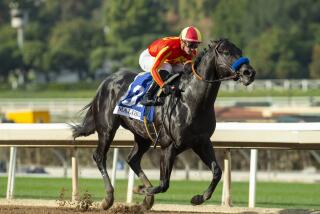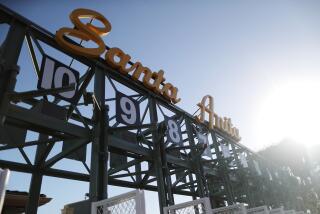Miniature Horses Measure Up Well
- Share via
Evita and Juan are alive and well in San Juan Capistrano.
Acclimating well, too, except maybe for showing some irritation over renditions of the song, “Short People Ain’t Got Nobody.”
Juan and Evita are miniature horses purchased at Argentina’s world-famed Falabella breeding farm by Pam and Gary Ziebarth of San Juan Capistrano. The minis from that farm are a special and unique breed arrived at after many generations of selection and crossings of small English Shetlands and a small specimen of the local Carillo race.
Their average height is 28 inches, measured from the base of the top hairs of the mane to the ground while standing squarely. Their adult weight ranges from 40 to 60 pounds, not much more than a large dog.
“We really didn’t go to Argentina with the idea of buying two minis,” Pam said. “We had read about the farm in a tour book and, since we both love animals, decided to visit.
“We saw about 600 head grazing on 2,000 acres of land . . . and we just couldn’t resist.”
It was an expensive impulse--about $15,000 for the horses, transportation and a week in quarantine when they arrived in the United States--but probably not a bad investment, considering a Falabella stud just sold at auction in Oregon for $32,000.
The Ziebarths plan to breed their pair next spring.
The big question is: If you can’t ride them (and you certainly can’t if you weigh more than 50 pounds), what are they good for?
“If you ask my husband, the answer would probably be ‘nothing,’ ” said Pam, who goes on to provide some different answers. “Taking care of these little ones was my two sons’ first experience with horses. They learned all about horse care without becoming intimidated.
“They learned how to take a horse’s temperature, how to clip a horse, groom it--how to teach them ground manners and more without the fear of being kicked or run over in the process.”
Many owners of minis are known to keep them at home (even in the house!), but the Ziebarth pair are stabled at the Ortega Equestrian Center, where “they’ve become sort of mascots,” according to Pam.
Jill Coffey, an Orange County breeder of minis, says the little horses are perfect for older people who are no longer physically able to handle full-sized breeds. Plus, there’s the obvious matter of space. “You can have eight minis in an area that would only house one full-sized horse,” says Coffey, who has 22 minis on her property in Newport’s Back Bay.
“Because they were bred down from English Shetlands that were used to pull ore from mines, they are extremely strong as well and make excellent driving horses.”
Serious breeding of minis in the United States was begun in the 1950s by West Virginian Smith McCoy, who eventually developed a herd of 100 of what then were called “midget Shetlands.” Failing health forced him to sell off the herd in 1967.
Almost 10 years passed before the formation of the American Miniature Horse Assn., now the only registry in existence dealing exclusively with true miniatures.
To be registered, a horse must stand no more than 34 inches in height. The association’s Standard of Perfection calls for a “small, sound, well-balanced horse possessing the good conformation characteristics common to most breeds; showing refinement and femininity in the mare and boldness and masculinity in the stallion. It should give the impression of strength, agility and alertness.”
In a move designed to purify the bloodlines and maintain height, the association closed the registry, effective Dec. 31, 1987. That means that only those horses with a registered sire or dam are eligible for listing. There are about 30,000 American miniatures registered at this time.
Jill Coffey’s pet-quality minis start at $1,800, but the cost of show-quality animals can run into five figures.
More to Read
Sign up for The Wild
We’ll help you find the best places to hike, bike and run, as well as the perfect silent spots for meditation and yoga.
You may occasionally receive promotional content from the Los Angeles Times.






